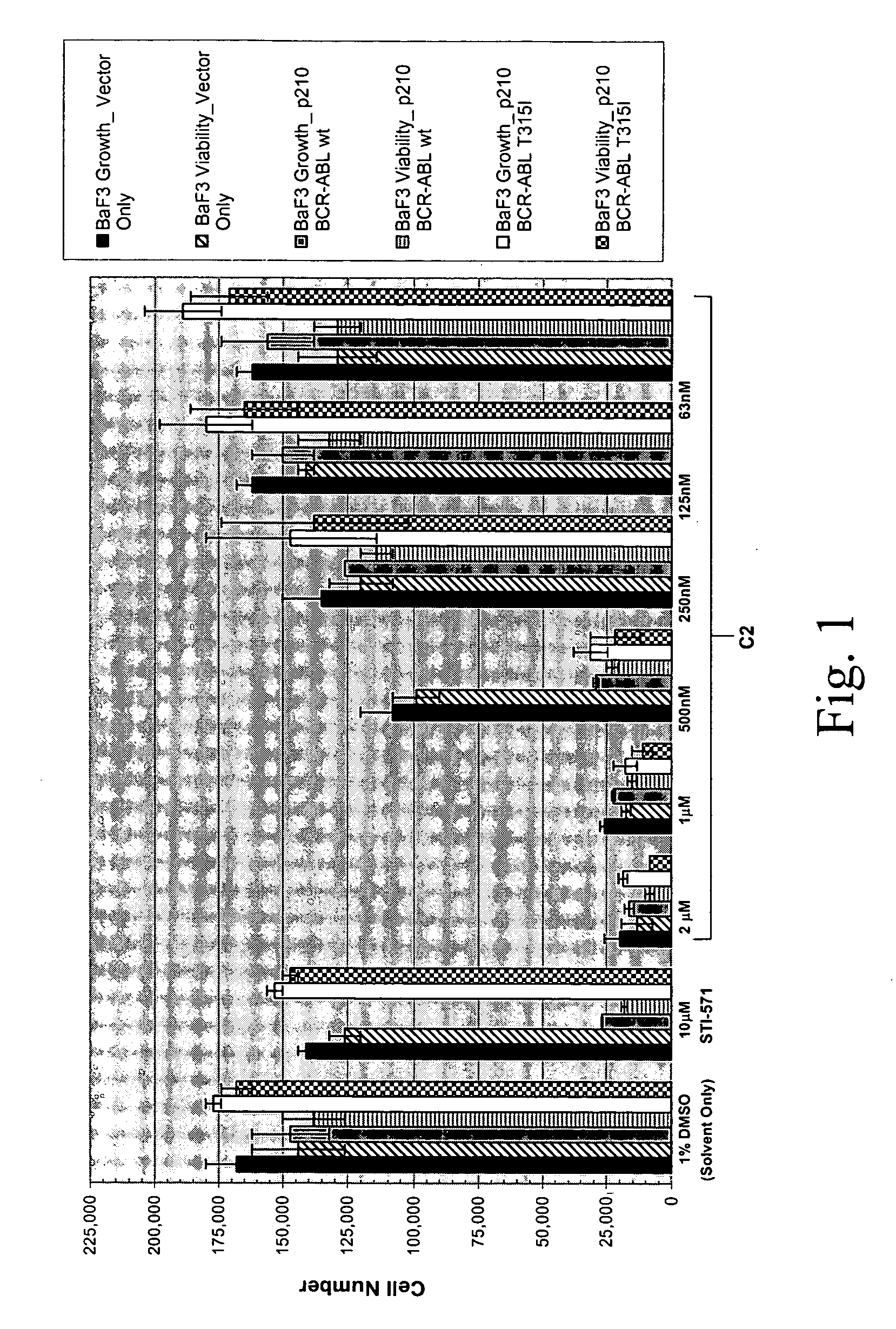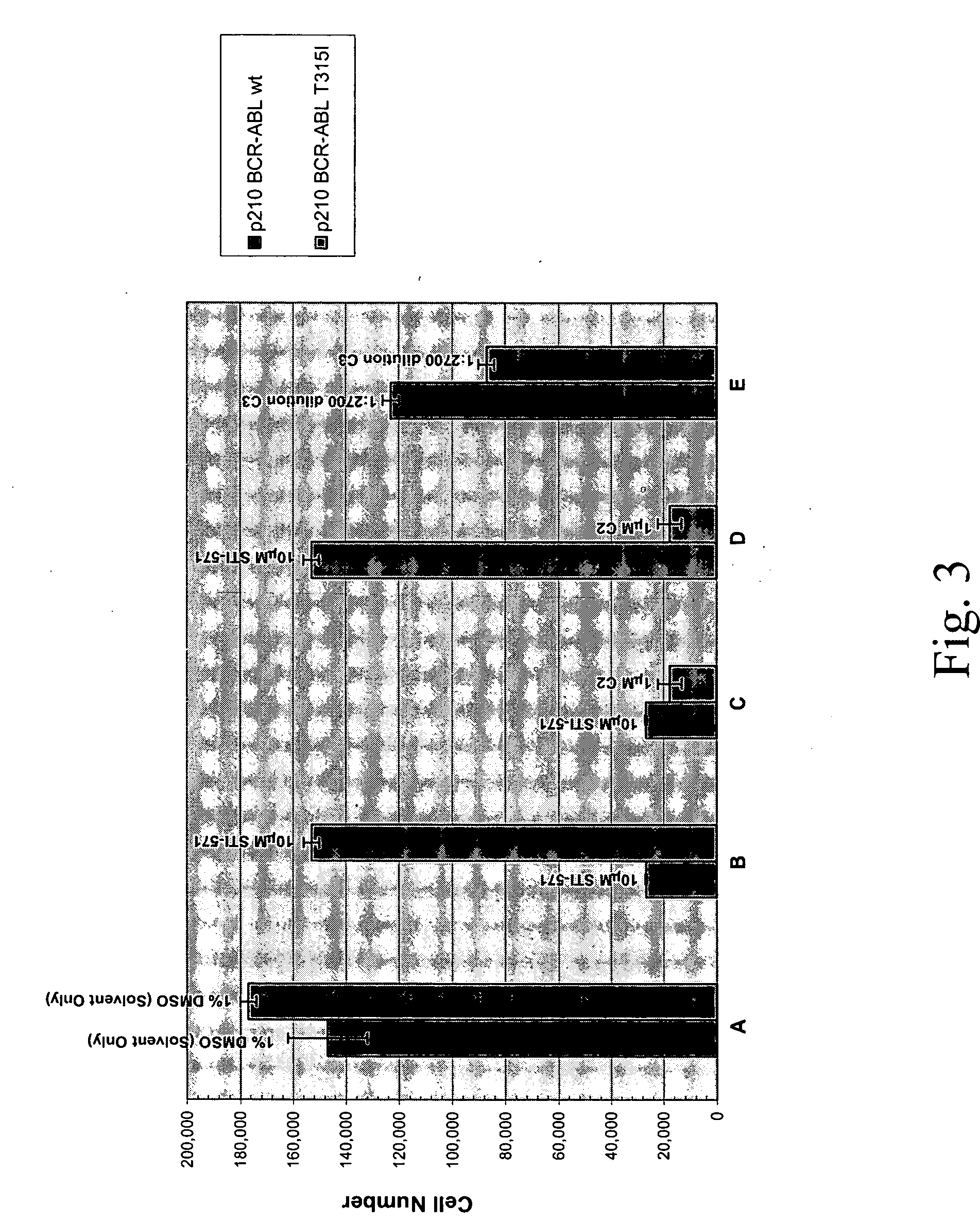Compounds and method of identifying, synthesizing, optimizing and profiling protein modulators
- Summary
- Abstract
- Description
- Claims
- Application Information
AI Technical Summary
Benefits of technology
Problems solved by technology
Method used
Image
Examples
example 1
Identification of a Protein Modulator
[0676] p210Bcr-Abl-T315I is a theramutein of the p210Bcr-Abl protein (p210Bcr-Abl) that is resistant to inhibition by imatinib mesylate (Gleevec, STI-571). The mutation at position 315 converts a threonine to an isoleucine residue and is one of several mutations that are observed among resistant or relapsed patients. This particular mutant, however, is the most resistant such theramutein yet identified.
[0677] A phenoresponse was determined for a Ba / F3 cell line engineered to overexpress the p210Bcr-Abl-T315I theramutein. The phenoresponse was determined reactive to non-transformed Ba / F3 cells and Ba / F3 cells that express the p210Bcr-Abl-wt prototheramutein The phenoresponse was the ability of the T315I mutants to grow to a higher cell saturation density under analogous culture conditions as compared to the control non-transformed Ba / F3 cell line, and to grow in the absence of interleukin 3 (IL-3), which is required for maintenance of the contro...
example 2
Phenoresponse-Based Optimization of a Protein Modulator
[0687] In this example, a compound previously identified according to the teachings of this invention is optimized for activity against its selected protein target. However, unlike methods typically used in the prior art, the optimization process herein is also performed entirely through the use of the phenoresponse-based cellular assay system. For completeness sake and to demonstrate the power of the methodology to refine, a cell-free assay system using recombinantly produced target enzyme is also used to independently demonstrate that the compounds that score positively in the phenoresponse-based cellular assay indeed also score positively in a cell-free assay system format that is standard in the art and uses recombinantly produced enzyme.
[0688] Compound C2 which was originally identified as an inhibitor of the T315I theramutein was subjected to a novel lead optimization program as follows. Various chemical modifications we...
example 3
Phenoresponse-Based Profiling of a Protein Modulator
[0695] The phenoresponse-based assay system of the invention can be used to profile the biological activity of a given compound with respect to its ability to inhibit or activate multiple distinct protein targets to differing extents. For example, in certain instances the skilled artisan may be interested in identifying or optimizing modulators of a given target protein where additional proteins are known that are distinct but highly related to the target POI. Such protein families may consist of two or more members that share a high degree of homology at both the DNA and amino acid sequence levels, yet the family members may have distinct functions within the cell. Through iterative application of the phenoresponse-based system described herein, one could create individual Test Cells expressing each of the distinct family members and then utilize three or four or more distinct Test Cell lines with corresponding defined phenorespo...
PUM
 Login to View More
Login to View More Abstract
Description
Claims
Application Information
 Login to View More
Login to View More - R&D
- Intellectual Property
- Life Sciences
- Materials
- Tech Scout
- Unparalleled Data Quality
- Higher Quality Content
- 60% Fewer Hallucinations
Browse by: Latest US Patents, China's latest patents, Technical Efficacy Thesaurus, Application Domain, Technology Topic, Popular Technical Reports.
© 2025 PatSnap. All rights reserved.Legal|Privacy policy|Modern Slavery Act Transparency Statement|Sitemap|About US| Contact US: help@patsnap.com



